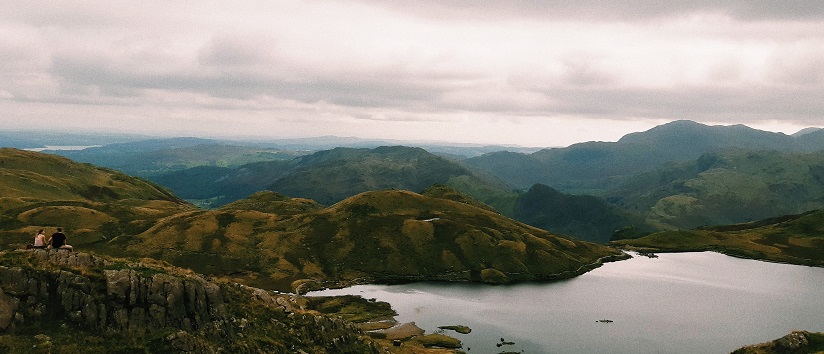How nature has grounded me in the here and now during trauma recovery
14 May 2021
One of the most pervasive symptoms of having experienced trauma in early childhood is the inability to be present. This can manifest in flashbacks, catastrophising, preoccupation with the past or ‘rumination’, feeling numb to your bodily sensations and the many facets of dissociation. A part of any recovery from trauma is reconciling this tendency to slip away from the present.
For me, dissociation is one of the scariest and uncomfortable symptoms of trauma. The best way I can think to describe it is feeling as though you’re being pulled out of the room or space that you’re in on a wire, but in slow motion.
Sometimes that sensation is replaced with the sudden realisation that your surroundings seem unreal, contrived, manufactured somehow, like the set of a film where people and objects feel incongruous, and the very molecular makeup of your body feels brittle.
“Traumatized people chronically feel unsafe inside their bodies: The past is alive in the form of gnawing interior discomfort… They often become expert at ignoring their gut feelings and in numbing awareness of what is played out inside. They learn to hide from their selves.”
Bessel Van Der Kolk, 'The Body Keeps The Score'
If trauma and it’s affects can be summed up as the act of learning to hide from ones self, as Van Der Kolk puts it, then for me, nature has the opposite effect.
I consider myself to be very privileged in that, growing up, nature was very important to my parents and family. Whether that be gardening, going for long walks in the sprawling countryside just beyond the limits of the council estate, or taking trips once a year to the Lake District when we could.
Understanding the importance of nature and it’s ability to soothe and heal from a young age meant, by the time we left the council estate and moved to a small village, wild, green spaces had been imbued with a kind of sacredness for me and I spent long hours, on my own, wandering the paths, fields and woodlands.
As I got older and we moved further into the city than we had ever lived before, I regularly sought out the small enclave of trees and ivy laden ground that the Spring Bank West cemetery in Hull provided. It was a feeling of calm and almost meditative peace as I walked away from the road, deep into the trees and overgrown cemetery grounds, slowly noticing the sounds of the city dissipating behind me.
- See also: 'Could green social prescribing provide the link between mental and physical health?'
- See also: 'Forest bathing: how returning to the trees can decrease symptoms of anxiety'
- See also: '“Climb your mind” The relationship between mental adversity and the mountains'
I have been in trauma therapy since last October and one of the first things my therapist and myself established was safe, comforting spaces that I can ‘visit’ in my mind, both in sessions if I become overwhelmed or dissociated but also as a tool that I can utilise in my daily life.
When discussing these safe, comforting spaces, it was immediately apparent that all three of them were natural places.
Engaging the five senses and listing your surroundings are easily recognisable methods of ‘grounding’. This is something therapists often first touch upon with trauma survivors. Finding ways in which to ground in the present is an easy way to bring someone out of that tendency to slip into re-traumatising rumination, flashbacks and dissociation, that as I mentioned earlier are staples of any trauma disorder.
As a means of explaining how nature has been the most useful tool in grounding for me, I want to dive into one of those safe, comforting spaces I established in therapy. Here, I’ll explore how you can activate the same beneficial results from being in nature, but at home through visualisation.
Looking down on Stickle Tarn up the Langdale Pikes in the Lake District
This space, the lead image of this article, is somewhere I have been visiting since I was little and is unlike anywhere else I’ve ever been. As you wind your way up the mountain alongside a rocky stream, you eventually reach a plateau where Stickle Tarn resides. Crouching over the glassy, still surface of the tarn like great giant heads are two pikes, Harrison Pike and Pike of Stickle.
As you ascend towards these pikes, a place called Pavey Arc, you can look back on the tarn and the Langdale Valley. The view is stunning. On a clear day, you can see for miles, right out to the coast. One of my favourite things is noticing how the green of the mountains fades in saturation the farther away they are, like misty distant fairylands.
During my most recent trip to the Lake District, last September before yet another lockdown in November, we visited Langdale (as we all affectionately call it in my family).
Last year was, at times unbearably stressful and I carried that stress with me every day, in my shoulders, in my heart rate, in my rushing thought streams. But looking over stickle tarn, feeling the expanse of the mountains, the grass wet from the falling low cloud underneath – I felt at peace.
In using this space as a place of safety, comfort and grounding my therapist asked me: “What do you hear? What do you see? What do you smell and feel? Is it warm? Cold? Is there a breeze?”
Immediately my memory and imagination turn on and I see the buzzards flying high on thermal currents, hearing them call to each other, the mountain tops stretching out to Windermere and beyond, I smell the rain saturated ground, the soil, the grass, I feel the air around me, chilled by the elevation of the mountain but that still retains some of the warmth of the day, I feel the light breeze cooling the droplets of sweat on my forehead.
This visualisation technique can of course be applied to any safe space, it could be your teen bedroom, the place you would gather with friends in your hometown, a museum, a room in a grandparent’s house.
For me, the richness of the space I just described makes it the perfect place of grounding. In moments where I am tangled up in upsetting, traumatising thoughts when all I want is to sleep, or when I’m out alone and something happens to spike my anxiety, I can close my eyes, and I go through those steps: hear, see, feel.
There is another aspect of natural surroundings that has a particularly soothing effect on my mind.
With trauma, dissociation, catastrophising and anxiety, it is very easy to feel like that is all there is. When you feel unwell, it can feel like you’re in a dark room, simultaneously claustrophobic and yet chasm like, infinite. When I enter a wide, natural, expansive space I am reminded of just how big the world really is and how a part of it I am.
When I visited the Lake District in September last year, I hadn’t started therapy and I was in the midst of one of the hardest years of my life for my mental health. I was extremely lucky to have had the opportunity for the respite that the trip provided and for the visual memories it continues to gift me.
Many people who could benefit from time in green spaces are not so privileged and may not even have the memory of one to be able to attempt visualisations.
This is why government and local council incentives for better green, urban and suburban spaces are so incredibly important, and more social prescribing centred around taking people out of the city into these spaces should absolutely be a priority.
As Chief Executive of The Mental Health Foundation said, “Nature is not a luxury, and everyone needs to access and experience its benefits to their mental health.”
Experiencing nature has been an invaluable tool in my recovery, both from the times I was well enough to visit in person but also, for when I have been in crisis or on the brink of a panic attack and I have been able to utilise visualisations of natural spaces that make me feel safe.
The longer I practice this visitation of my safe place, the view of Stickle Tarn from walking up to Pavey Arc, the elements come to me like a mantra: buzzards, mountain tops, wet grass, cool breeze and suddenly, it’s as if I’m there.


Comments
Write a Comment
Comment Submitted